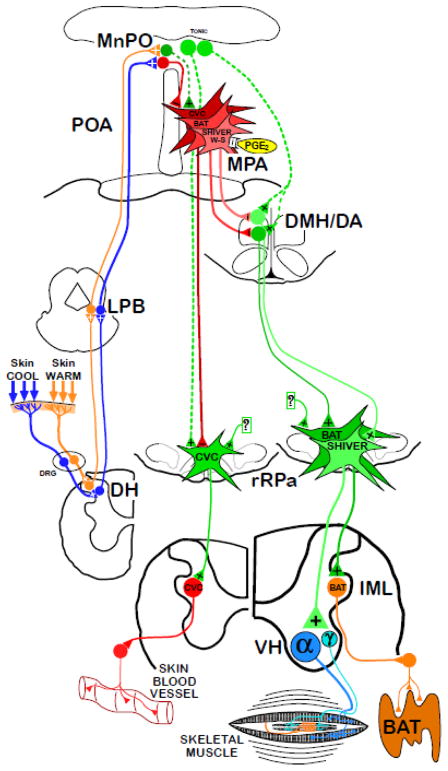Figure 1.
Functional neuroanatomical model for the fundamental pathways providing the thermoregulatory control and pyrogenic activation of cutaneous vasoconstriction (CVC), brown adipose tissue (BAT) and shivering thermogenesis. Cool and warm cutaneous thermoreceptors transmit signals to respective primary sensory neurons in the dorsal root ganglia (DRG) which relay this information to second-order thermal sensory neurons in the dorsal horn (DH). Cool sensory DH neurons glutamatergically activate third-order sensory neurons in the external lateral subnucleus of the lateral parabrachial nucleus (LPB), while warm sensory DH neurons project to third-order sensory neurons in the dorsal subnucleus of the LPB. Thermosensory signals driving thermoregulatory responses are transmitted from the LPB to the preoptic area (POA) where GABAergic interneurons (red) in the median preoptic (MnPO) subnucleus are activated by glutamatergic inputs from cool-activated neurons in LPB and inhibit each of the distinct populations of warm-sensitive (W-S) neurons in the medial preoptic area (MPA) that control CVC, BAT and shivering. In contrast, glutamatergic interneurons (dark green) in the MnPO are postulated to be excited by glutamatergic inputs from warm-activated neurons in LPB and, in turn, excite W-S neurons in MPA. Prostaglandin (PG) E2 binds to EP3 receptors on each of the classes of W-S neurons in the POA to inhibit their activity. The MnPO also contains neurons (light green) that provide an excitatory input to CVC premotor neurons in the rostral raphe pallidus (rRPa), and neurons (light green) that excite BAT- and shivering- promoting neurons in the dorsomedial hypothalamus and dorsal hypothalamic area (DMH/DA). Preoptic W-S neurons provide inhibitory control of CVC by inhibiting CVC sympathetic premotor neurons in the rostral ventromedial medulla, including the rRPa, that project to CVC sympathetic preganglionic neurons in the intermediolateral nucleus (IML). Preoptic W-S neurons providing inhibitory thermoregulatory control of BAT and shivering thermogenesis inhibit BAT sympathoexcitatory neurons and shivering promoting neurons, respectively, in the DMH/DA, which, when disinhibited during skin and core cooling, provide respective excitatory drives to BAT sympathetic premotor neurons and to skeletal muscle shivering premotor neurons in the rRPa. These, in turn, project, respectively, to BAT sympathetic preganglionic neurons in the IML, and to alpha (α) and gamma (γ) motoneurons in the ventral horn (VH) of the spinal cord.

